There are so many material options for commercial cladding panels that choosing one can be a significant undertaking. In this guide, you will:
- Learn about the most important considerations in this decision.
- Discover the range of cladding materials available on the market today.
- Learn about the qualities of fiber cement facade materials.
Continue reading for guidance on choosing the right commercial cladding material for your next building project.
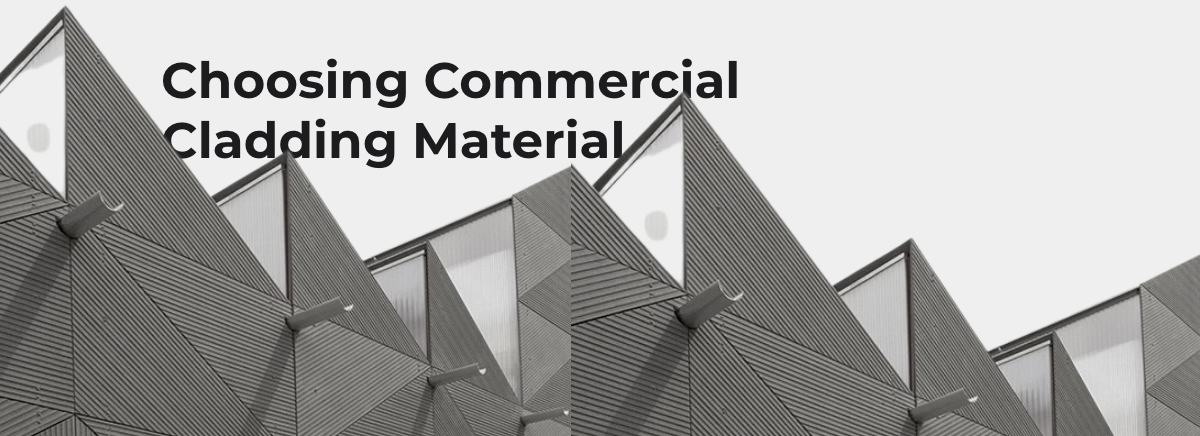
What to Consider When Choosing Commercial Cladding
When comparing cladding materials, there are a few central points to keep in mind across all types of projects and builds:
- Cost
- Installation
- Style
- Function
- Climate
- Maintenance
- Longevity
If you are deciding between the various commercial cladding options, account for the above elements to ensure you are prioritizing the most important features. You do not want to place too much focus on aesthetics at the expense of cost or longevity — similarly, you will not want to choose the cheapest option if it compromises the building's style.
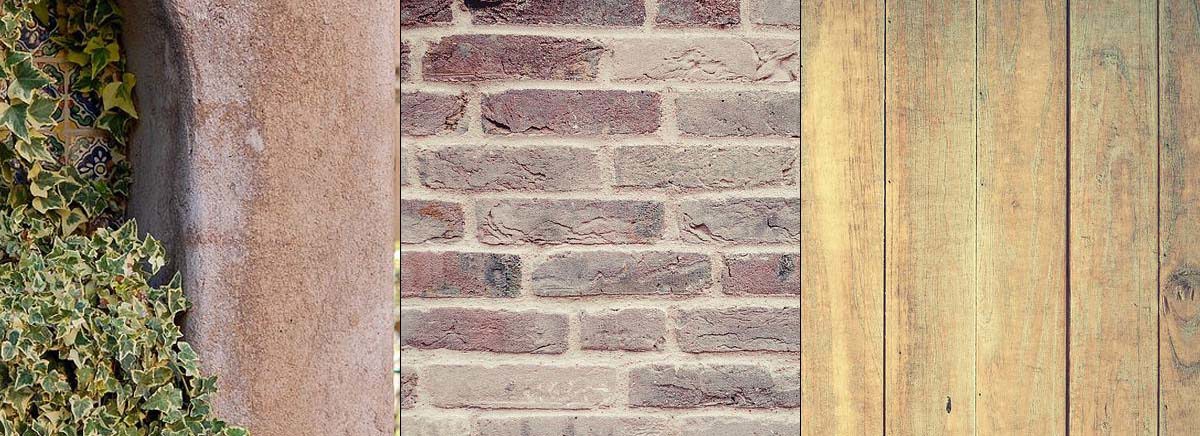
Commercial Cladding Materials
Certain cladding materials appear in commercial buildings more frequently than others. The following list details the pros and cons of different commercial cladding materials:
Wood
As one of the oldest building materials around, wood has been used in construction for over 10,000 years. Before the discovery of metal, wood was the primary building material, and builders used it for both interior support structures and exterior designs. Nowadays, concrete is a more popular structuring material, but many commercial buildings still use wood cladding.
Dark wood cladding is effective for creating a more rustic look on commercial buildings. If a client's industry involves the outdoors, such as a hunting and sporting goods store, they might choose a darker-stained wood cladding material to evoke a rough and ready ambiance to match their customers' expectations. Lighter wood cladding often evokes a hyper-modern feel, especially when structured vertically rather than the traditional horizontal orientation.
Concerning function, wood cladding is a popular choice for durability and energy efficiency. Wood cladding is common for building exteriors and decorative interior features. One of the biggest pros of using wood cladding is its sustainability. As a natural resource, wood is biodegradable while still being a sturdy and lasting building material. With responsible sourcing and environmental wood treatments, wood cladding can be an excellent green building material.
Stucco
Another historical building material, ancient civilizations created stucco by mixing aggregates with binder and water to create a wet paste that hardened into a strong material when completely dry. Due to its paste-like state when wet, builders would spread stucco onto surfaces like brick, adobe or metal if it was available. They could also add decorative features to the stucco when wet, which would then harden and become permanent features.
Today, stucco is still a common commercial cladding option. One of the most important factors in deciding whether stucco is right for a building is the climate. Stucco is permeable, so water can sometimes transfer from the outside to the structural materials through the stucco. If water freezes within the stucco, it can cause cracks to form and significantly impair the structure.
You are more likely to see stucco siding in warmer, arid climates such as the Southwest. In areas with low moisture levels and less risk of freezing temperatures, stucco is a perfect cladding choice. It is also extremely durable — there are even some examples of stucco that has lasted hundreds of years with the proper care and maintenance. Clients can also choose from various colors and textures with stucco cladding, making it a versatile design option.
Brick
Because not all locations have the dense vegetation to support wood as a building material, some ancient civilizations developed bricks. These air-dried mudbricks were very different from the fired bricks common in more modern constructions. As brick technology advanced, builders found that applying high heat to bricks made them significantly more durable.
Bricks come in different colors based on the chemical and mineral content of the base materials. Most commonly, you will see red or gray bricks used on commercial buildings. Some builders also paint over bricks to achieve a specific color, such as white, that bricks cannot naturally obtain. Bricks offer a traditional aesthetic at a cost-effective price point, making them attractive options for commercial buildings.
Some other benefits of brick cladding include its durability and insulation, plus the added advantage of being low maintenance. Bricks are some of the strongest building materials, and brick cladding can offer superior protection to buildings that often experience extreme natural elements such as wind, rain and hail. Bricks are also great insulators, making them a popular choice in cooler, more damp climates. Bricks convey a classic look that is often used for commerical buildings searching for a traditional aesthetic. What they offer in performance, bricks lack in sustainability. They have the highest CO2 impact of all building materials on the Construction Material Pyramid developed by the Centre for Industrialised Architecture (CINARK) at the Royal Danish Academy in 2019.
Stone
Stone, another prehistoric building material, is a great commercial cladding option. Many of the most wondrous structures in the world, from the pyramids in Egypt to the ancient Roman Colosseum, have been constructed with stone. The long-lasting and durable qualities of stone cladding make it an incredible choice for building.
Stone also adds an extraordinary aesthetic element to a building. Choosing stone as a facade material for a commercial structure offers a wide range of design options. Due to its huge variety of colors, textures and sizes, stone can fit into various design elements while maintaining a timeless, natural beauty.
Regarding function, stone works well in virtually all climates. Being non-porous, stone cladding will not let water through, so it is safe to use in damp and cold climates. These properties of stone also mean it is an efficient insulator, keeping heating and cooling costs down. Stone is also weather- and fire-resistant, making it a safe option for most commercial buildings if installed correctly.
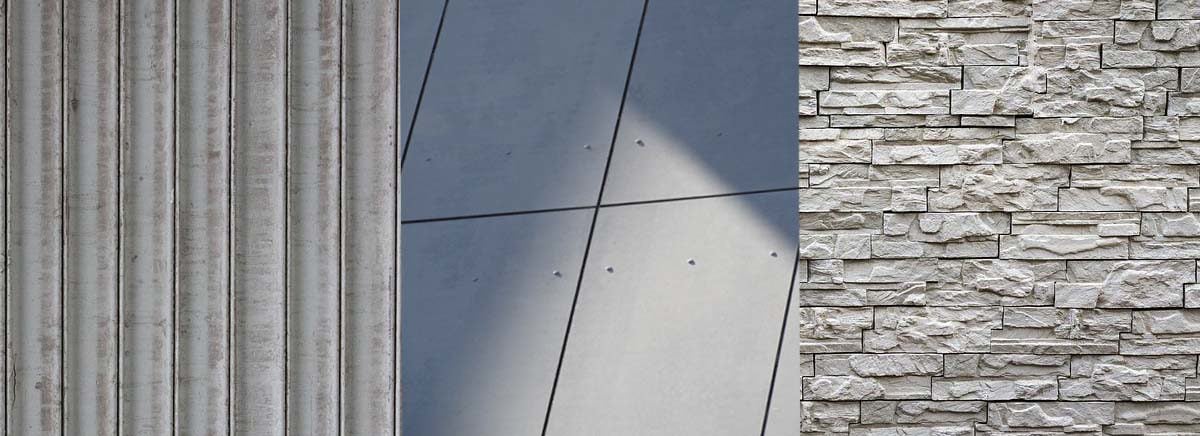
Porcelain
When you think of porcelain, you likely imagine fine china, pottery or bathroom tiles. However, porcelain is also a durable cladding option for building exteriors. Porcelain is a ceramic made by firing a material in a kiln at extremely high temperatures. One of the strongest features of porcelain cladding is its water resistance. Porcelain absorbs water at extremely low rates, so there is a low likelihood of water seeping between the cladding and insulation and damaging a building's structure.
Porcelain cladding is also a beautiful building material with numerous colors and finishes available. It is a natural material with excellent fire-resistant properties, so using porcelain cladding is a safe choice for construction. Like natural stone, porcelain tends to an expensive material, and while it is generally lighter than stone, it can be heavier than other facades.
Metal
Most often, metal appears in a building's interior structure, but some types of metals work well as cladding. Steel, aluminum, zinc and copper are the four most commonly used metals for cladding. Often, metal cladding has a non-structural purpose, providing the underlying building structure with protection from the elements and offering a distinct appearance.
There is almost an endless array of forms and finishes for metal cladding. Dark, matte finishes are popular, but you can select metal cladding in almost every color of the rainbow. Depending on the metal, you may be able to choose different finishes and textures, such as sand blasted, brushed, mirrored and other geometric patterns.
Keeping temperature changes in mind when using metal cladding is essential, as most metals will expand in hot temperatures and contract in cold ones. Metal's durability, however, means it is a good choice for commercial cladding.
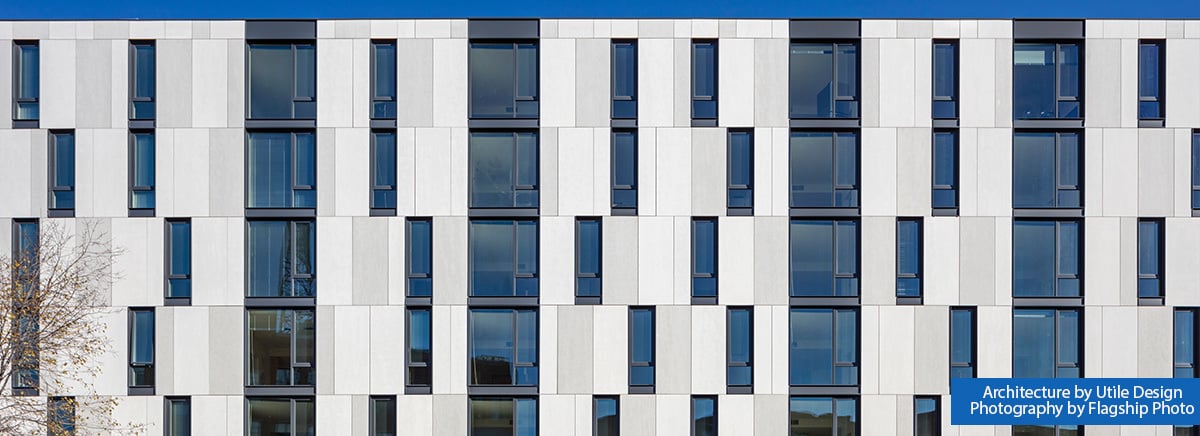
Fiber Cement
If you are looking for a cladding material that has great benefits and durability at a reasonable cost, consider fiber cement. While this material is not ancient like some of these others are, fiber cement cladding has made a huge impact in the relatively short period it has been around.
Fiber cement comes in various shapes, tones and textures that are great for mimicking stone and concrete. The panels even act like stone and age naturally on a building. They come in a wide range of colors and textures you can combine for unique, eye-catching designs. They can be perforated, cut into patterns and arranged vertically, horizontally and even randomly. A nearly endless array of configurations and designs allows fiber cement to support creative and specialized applications.
Fiber cement panels can be used for:
Geometric paneling: Cut and arrange the panels in virtually any way for crisp geometric designs, including irregular shapes.
Curved walls: Although the panels are flat, fiber cement can be gently eased around curved walls.
Roofing: Fiber cement panels can offer decorative cladding on rooftops, great for wrapping the entire building in the same cladding or creating an attractive contrast.
Brise Soleil and shading: For unique visual appeal and shading, angled panels can offer coverage and create a continuous facade.
Shiplap: With the help of slight angles and a horizontal arrangement, fiber cement can mimic the textured shiplap appearance.
Perforations: Cut-outs in fiber cement panels add variety and are great for playing with light and shadows.
Why Choosing Commercial Cladding Materials Is Important
Since cladding is a building's exterior facade, think of it as a first impression. It can tell a story about the structure's function and purpose or show a company's values and goals. Certain cities and municipalities may have strict building codes that require certain materials, and others may be more relaxed in their regulations, allowing for a wider range of materials.
One of the most important factors in choosing architectural materials is the region's climate. You would not want to use stucco in areas like the Pacific Northwest, where it rains most of the year and where there are weeks or months of freezing temperatures. Along the same lines, you would certainly want to avoid using wood cladding in arid areas prone to wildfires. Knowing an area's climate and typical weather patterns can help you narrow down the best choices for cladding materials.
Another essential element in choosing the best cladding for a building is how the material impacts the construction. Porcelain tiles lend an air of sophistication due to their higher price point, so they might attract more upscale business — but fiber cement can offer similar aesthetic options at a lower price.
Fiber Cement vs. Other Cladding Materials Fiber cement is comprised of cement, wood fiber and natural additives, which create a durable, cement-like material from which builders can form various shapes and styles for commercial cladding. Continue reading to find out why fiber cement is the best material for external cladding.
1. Price
Since most building projects have to follow a strict budget, spending less on cladding will always help the bottom line. However, cutting corners on quality to reach a lower price point often ends in disaster. If you are looking for a high-quality material that will not break the bank, fiber cement is the perfect option. Plus, since it allows for practically endless customization opportunities, clients can get the exact look they want at a lower price than other cladding options.
2. Style
Different types of fiber cement can have diverse appearances based on the distribution of the materials. Some may appear rough and ridged, while other styles might have a more sleek and smooth texture. One of the most popular finishes for fiber cement is elements like ridges to add an extra component of visual appeal. Fiber cement also offers versatile shapes, and many commercial buildings can make an impact with geometric-patterned fiber cement.
Another positive element of fiber cement compared to other cladding materials is that the color is fully customizable. You can choose a wide range of colors and tones for your fiber cement, many options are through-colored, meaning no touch-ups are necessary. This helps the fiber cement siding age naturally as stone would.
3. Durability
Whether a cladding material is worth the cost ultimately comes down to how long it will last and stay in good condition. Fiber cement is one of the most durable cladding options on the market, and it is suitable for virtually any climate. Unlike wood, fiber cement resists warping and rotting, and it is incredibly water-resistant, unlike stucco cladding. Additionally, this material is the perfect option for fire-, tornado- and hurricane-prone areas.
Fiber cement has a long life span compared to other cladding options and holds up to extreme temperatures and conditions especially well. With a long life span and a high resistance to damage, fiber cement cladding is a durable choice at an approachable price.
4. Maintenance
Another element of fiber cement that makes it a superior choice for commercial cladding is its low maintenance requirements. While vinyl and aluminum may need frequent power-washing to eliminate the buildup of contaminants, fiber cement does not require these regular washings. Having a cladding material that takes little effort to maintain is excellent for commercial buildings, especially those with large square footage or multiple stories.
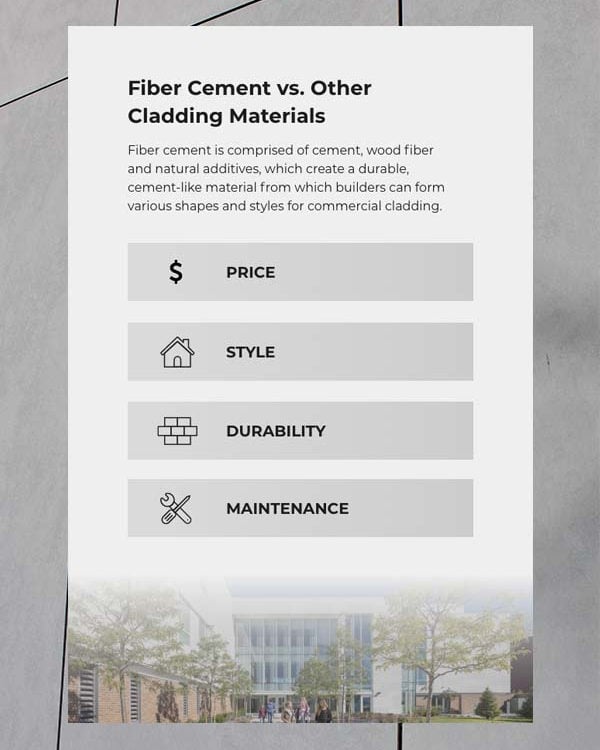
Discover the Difference of EQUITONE Fiber Cement Panels
We take a different approach to commercial cladding materials because our fiber cement is constructed by architects, for architects. We offer five premium texture options in addition to almost endless color and shape configurations to suit every project. Furthermore, by installing in a rainscreen system that allows water to permeate and evaporate through the system, the cladding can prevent water damage and mold better than any other material.
Request a free sample to see the EQUITONE difference firsthand and examine which fiber cement option works best for your build. If you need any more information or have questions about a future project, feel free to contact our team.